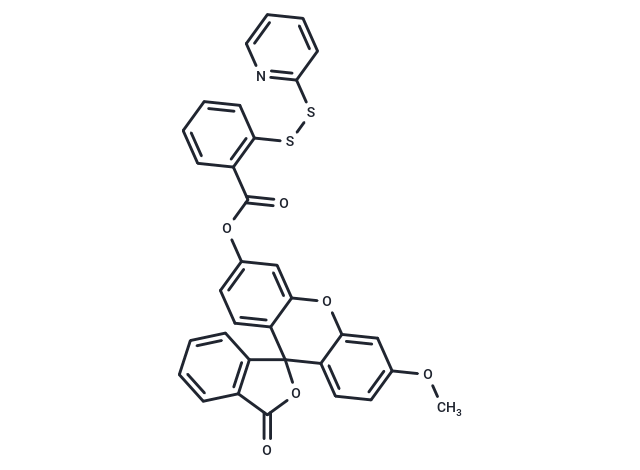Shopping Cart
Remove All Your shopping cart is currently empty
Your shopping cart is currently empty
WSP-1 is a selective 2-pyridyl disulfide fluorescent probe for hydrogen sulfide detection and bioimaging.

| Pack Size | Price | USA Warehouse | Global Warehouse | Quantity |
|---|---|---|---|---|
| 1 mg | $58 | - | In Stock | |
| 5 mg | $177 | - | In Stock | |
| 10 mg | $283 | - | In Stock | |
| 25 mg | $478 | - | In Stock | |
| 50 mg | $698 | - | In Stock |
| Description | WSP-1 is a selective 2-pyridyl disulfide fluorescent probe for hydrogen sulfide detection and bioimaging. |
| Cell Research | 1. Hydrogen sulfide detection Experimental steps: 1. Prepare WSP-1 solution: WSP-1 is usually dissolved in an appropriate solvent (such as DMSO) and then mixed with cell culture or biological samples. Its concentration is usually between 1-5 μM (can be adjusted according to experimental requirements). 2. Incubate the cell/tissue sample: Add WSP-1 solution to live cells or tissues, usually 30-60 minutes, allowing the probe to enter the cells and react with hydrogen sulfide. 3. Fluorescence imaging: Use a fluorescence microscope or imaging system to monitor the fluorescence signal. WSP-1 emits fluorescence at a specific wavelength in the presence of hydrogen sulfide, usually within the green fluorescence range. 4. Data analysis: According to the fluorescence intensity, the concentration of hydrogen sulfide in cells or tissues can be quantitatively analyzed. 2. Application in cell and animal models Experimental steps: 1. Preparation of cell/animal model: Prepare appropriate cell lines or animal models, inject or add WSP-1 probes through cell culture. 2. Monitoring and imaging: Use a fluorescence microscope or multiphoton microscope to capture fluorescence images at appropriate time points to analyze the dynamic changes of hydrogen sulfide. 3. Results analysis: The concentration of hydrogen sulfide and its relationship with pathological status were evaluated through fluorescence images and quantitative analysis. 3. Research on hydrogen sulfide: Experimental steps: 1. Drug intervention or mutation model: Change hydrogen sulfide levels in cells or animals by adding synthesizers or inhibitors of hydrogen sulfide (such as inhibitors of certain hydrogen sulfide-generating enzymes). 2. Fluorescence monitoring: Monitor the changes in the fluorescence signal generated by WSP-1 to evaluate the concentration changes of hydrogen sulfide under different experimental conditions. 3. Results analysis: Fluorescence signals are used to quantitatively analyze the relationship between hydrogen sulfide and related physiological or pathological events (such as heart disease, neurodegenerative diseases, etc.). Notes: 1. Solubility and stability: WSP-1 has good solubility, but when used, it should avoid direct contact with strong reducing agents or high concentrations of hydrogen sulfide to avoid affecting its performance. 2. Background interference: Background fluorescence in certain cells or tissues may interfere with measurements. Imaging conditions should be optimized and controlled experiments should be conducted when used. 3. Cell permeability: WSP-1 has a high permeability and can directly enter the cells and react with endogenous hydrogen sulfide, but for some cell types, it may be necessary to optimize experimental conditions. |
| Molecular Weight | 591.65 |
| Formula | C33H21NO6S2 |
| Cas No. | 1352750-34-5 |
| Smiles | O=C(OC1=CC=C2C(OC3=CC(OC)=CC=C3C42OC(=O)C=5C=CC=CC54)=C1)C=6C=CC=CC6SSC7=NC=CC=C7 |
| Color | White |
| Appearance | Solid |
| Storage | keep away from direct sunlight | Powder: -20°C for 3 years | In solvent: -80°C for 1 year | Shipping with blue ice/Shipping at ambient temperature. | ||||||||||||||||||||||||||||||
| Solubility Information | DMF: 20 mg/mL (33.8 mM), Sonication is recommended. DMSO: 8.53 mg/mL (14.42 mM), Sonication is recommended. | ||||||||||||||||||||||||||||||
Solution Preparation Table | |||||||||||||||||||||||||||||||
DMSO/DMF
DMF
| |||||||||||||||||||||||||||||||
| Size | Quantity | Unit Price | Amount | Operation |
|---|

Copyright © 2015-2025 TargetMol Chemicals Inc. All Rights Reserved.